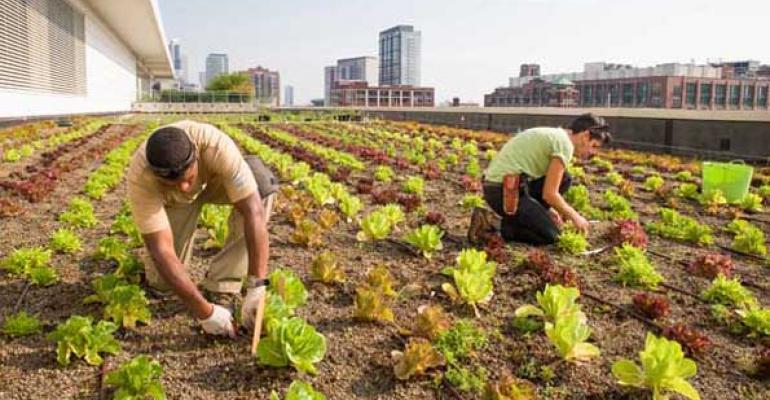Harvest season is winding down for restaurants that planted rooftop gardens this year, although the image of white-coat-clad chefs gently harvesting herbs and microgreens just prior to dinner service will linger in customers’ minds for a long time. If you’re thinking about trying something similar next year, be aware that restaurants can gain much more than foodie cred when they install a green roof.
Green roofs and rooftop gardens refer to vegetative layers that partially or completely cover a building’s roof. Their use is growing nationally at a triple-digit rate, fueled in large part by the urban farming movement. According to the experts at Green Roofs for Healthy Cities and Lennox Industries, these are the primary advantages green roofs offer to restaurants:
1. Heat reduction. A green roof’s plantings and barriers keep the top floor of a building significantly cooler than a traditional roofing system by protecting against the sun’s constant, direct radiant heat. By absorbing heat, green rooftops also lower ambient temperature, thus aiding in the reduction of “urban heat island” impact to be more consistent with the surrounding countryside.
2. Storm water management. Green roofs can intercept between 15–90 percent of rooftop runoff, helping to reduce the amount of storm water entering local waterways. During periods of heavy rainfall or snowmelt, green roofs can help divert water from the sewer systems, preventing overflow into nearby bodies of water.
3. Increased energy efficiency and lower utility costs. By deflecting heat and providing a layer of vegetation and trapped air, green roofs offer increased insulation, which cuts energy use and electricity expenditures.
4. Extension of the life of a conventional roof. When installed correctly, a green roof can extend the life of a conventional roof by three to four times by protecting the roof surface from UV light, preventing large temperature fluctuations and combating normal wear and tear.
5. Public image. Installing a green roof can help you make a highly visible statement, showing your customers and other community members that you are taking part in mitigating climate change, combating air and water pollution and increasing biodiversity. It also provides an opportunity for your restaurant to showcase its sustainability policy and garner positive press.
6. All the extras. Green roofs are good sound insulators, reducing the impact of noise to areas below the roof. What’s more, air quality improvements from a green roof’s plant photosynthesis reduce the negative impact of carbon dioxide and produces oxygen, helping to filter out airborne pollutants. Finally, with a little creativity, green roofs can also incorporate gardens, accommodate threatened native plant species and even offer food supply for birds and insects, further helping to improve sustainability and biodiversity.
Operators who want to investigate green roof possibilities further can check out “Introduction to Rooftop Urban Agriculture,” a short course available from Green Roofs for Healthy Cities.





